|
|
|
 |
|
|
|
|
MAGLEV
The New Mode of Transport for the 21st Century
by James Powell and Gordon Danby
From the Summer issue of 21st Century Science & Technology (full pdf)
The inventors of the world’s first superconducting maglev system tell how magnetic levitation can revolutionize world transportation, and even carry payloads into space.
|
|
|
|
|
|
|
Maglev is a completely new mode of transport that will join the ship, the wheel, and the airplane as a mainstay in moving people and goods throughout the world. Maglev has unique advantages over these earlier modes of transport and will radically transform society and the world economy in the 21st Century. Compared to ships and wheeled vehicles—autos, trucks, and trains—it moves passengers and freight at much higher speed and lower cost, using less energy. Compared to airplanes, which travel at similar speeds, Maglev moves passengers and freight at much lower cost, and in much greater volume. In addition to its enormous impact on transport, Maglev will allow millions of human beings to travel into space, and can move vast amounts of water over long distances to eliminate droughts.
In Maglev—which is short for MAGnetic LEVitation—high speed vehicles are lifted by magnetic repulsion, and propelled along an elevated guideway by powerful magnets attached to the vehicle. The vehicles do not physically contact the guideway, do not need engines, and do not burn fuel. Instead, they are magnetically propelled by electric power fed to coils located on the guideway.
|
|
|
|
|
|
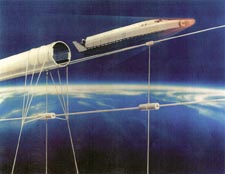 |
Artist’s illustration of StarTram, a magnetically levitated low-pressure tube, which can guide spacecraft into the upper atmosphere.
|
|
|
|
Why is Maglev important? There are four basic reasons.
First, Maglev is a much better way to move people and freight than by existing modes. It is cheaper, faster, not congested, and has a much longer service life. A Maglev guideway can transport tens of thousands of passengers per day along with thousands of piggyback trucks and automobiles. Maglev operating costs will be only 3 cents per passenger mile and 7 cents per ton mile, compared to 15 cents per passenger mile for airplanes, and 30 cents per ton mile for intercity trucks. Maglev guideways will last for 50 years or more with minimal maintenance, because there is no mechanical contact and wear, and because the vehicle loads are uniformly distributed, rather than concentrated at wheels. Similarly, Maglev vehicles will have much longer lifetimes than autos, trucks, and airplanes.
|
|
|
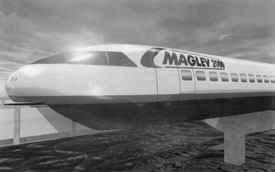 |
The Maglev 2000 can operate in the open air, or in underground tunnnels. Using a low-pressure tunnel will make it possible to get from Los Angeles to New York in 1 hour.
|
|
|
|
Second, Maglev is very energy efficient. Unlike autos, trucks, and airplanes, Maglev does not burn oil, but instead consumes electricity, which can be produced by coal-fired, nuclear, hydro, fusion, wind, or solar power plants (the most efficient source now being nuclear). At 300 miles per hour in the open atmosphere, Maglev consumes only 0.4 megajoules per passenger mile, compared to 4 megajoules per passenger mile of oil fuel for a 20-miles-per-gallon auto that carries 1.8 people (the national average) at 60 miles per hour (mph). At 150 mph in the atmosphere, Maglev consumes only 0.1 of a megajoule per passenger mile, which is just 2 percent of the energy consumption of a typical 60-mph auto. In low-pressure tunnels or tubes, like those proposed for Switzerland’s Metro system, energy consumption per passenger mile will shrink to the equivalent of 10,000 miles per gallon.
Third, Maglev vehicles emit no pollution. When they consume electricity, no carbon dioxide is emitted. Even if they use electricity from coal- or natural-gas-fired power plants, the resulting CO2 emission is much less than that from autos, trucks, and airplanes, because of Maglev’s very high energy efficiency.
Maglev has further environmental benefits. Maglev vehicles are much quieter than autos, trucks, and airplanes, which is particularly important for urban and suburban areas. Moreover, because Maglev uses unobtrusive narrow-beam elevated guideways, its footprint on the land is much smaller than that of highways, airports, and railroad tracks.
Fourth, Maglev has major safety advantages over highway vehicles, trains, and airplanes. The distance between Maglev vehicles on a guideway, and the speed of the vehicles, are automatically controlled and maintained by the frequency of the electric power fed to the guideway. There is no possibility of collisions between vehicles on the guideway. Moreover, since the guideways are elevated, there is no possibility of collisions with autos or trucks at grade crossings.
|
|
|
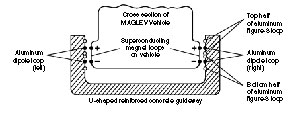 Figure 1 Figure 1
SCHEMATIC OF MAGLEV VEHICLE IN U-SHAPED GUIDEWAY
In this Maglev system, which is similar to the one in Japan, the vehicle has superconductor loops (approximately 600 kiloamp turns). The guideway has aluminum loops at normal temperature; their loop currents are generated by magnetic induction as vehicle loops move past them. The induced currents in “figure-8” guideway loops levitate and vertically stabilize the vehicle.
The left and right dipole guideway loops are electrically connected to form a circuit. Net flux and current in the circuit is zero when the vehicle is centered in the guideway. If the vehicle moves left from the center, the magnet force develops to push it back to the center.
|
|
|
|
How Does Maglev Work?
Maglev has been a dream since the early 1900s. Emile Bachelet proposed to magnetically levitate trains using attached alternating current (AC) loops above conducting metal sheets, such as aluminum, on the ground. Other ideas followed, based on conventional electromagnets and permanent magnets. However, all these proposals were impractical. Either power consumption was too great, or the suspension was unstable, or the weight that could be levitated was too small.
The first practical Maglev system was proposed and published by us in 1966.1 It was based on Maglev vehicles carrying lightweight superconducting magnets that induced currents in a sequence of ordinary aluminum loops mounted along a guideway. These induced currents interacted with the superconducting magnets on the vehicle, levitating it above the guideway. The levitated vehicle is inherently and passively stable against all external forces, including cross-winds, and the centrifugal forces on curves, whether horizontal or vertical. If a cross-wind tries to push the vehicle sideways, an opposing magnetic force is automatically generated that holds the vehicle on the guideway. If the vehicle is pushed down towards the guideway, the levitation force automatically increases, preventing contact. If an external force lifts the vehicle away from the guideway, the levitation force decreases, and the vehicle drops back towards its equilibrium suspension height.
|
|
|
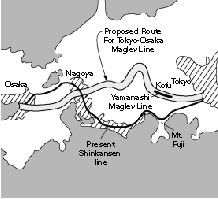 |
Figure 2
PROPOSED ROUTE FOR TOKYO-OSAKA MAGLEV LINE
The wide gray line is the 300-mile proposed Tokyo-Osaka line in central Japan. The thin line is the present railway line. The location of the existing Yamanashi Maglev line is shown (near Kofu).
|
|
|
|
The levitation process is automatic, as long as the vehicle moves at a speed above its lift-off speed. Below this speed, which is in the range of 20 to 50 mph depending on design, the finite electrical resistance of the aluminum loops on the guideway decreases the induced currents to the point where the magnetic force is too weak to levitate the vehicle. The vehicle is supported at low speeds by auxiliary wheels, or by locally powering the guideway. These lower-speed sections of guideway are very short and are needed only when a vehicle accelerates out of a station or decelerates into it.
Our 1966 paper sparked intense interest in Maglev in many countries. It was quickly realized that superconducting magnets made Maglev practical. Basically, superconducting magnets are extremely powerful and lightweight permanent magnets. Because they have zero electrical resistance, even when they carry currents of hundreds of thousands of amps, their power consumption is zero, except for a very small amount of electric power for the refrigerators which keep the superconductor at cryogenic temperature.
After our 1966 publication, Maglev programs started in the United States, Japan, Germany, and other countries. Sadly, U.S. Maglev development stopped in the early 1970s (although it has since recommenced—more on that later), when the Department of Transportation decided that High Speed Rail and Maglev were not needed in the United States because auto, trucks, and airplanes would suffice for the indefinite future.
|
|
|
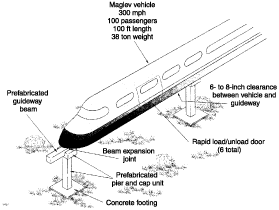 |
Figure 3
MAGLEV 2000 OF FLORIDA VEHICLE PARAMETERS
An M-2000 vehicle on a prefabricated narrow-beam guideway.
|
|
|
|
However, major development programs continued in Japan and Germany. Japan focussed on superconducting Maglev, and now has a commercially ready passenger Maglev system based on our original inventions. Japan Railways operates Maglev vehicles at speeds up to 350 mph on their 20-kilometer guideway in Yamanashi Prefecture. Japan Railways vehicles operate in the open atmosphere and in deep mountain tunnels, both as individual units, and as linked sets of up to five units. A Japan Railways vehicle on the Yamanashi guideway is shown here.
The basic features of superconducting Maglev are illustrated in Figure 1 for a U-shaped guideway similar to the one in Japan. The set of passive, null-flux aluminum loops on the sidewalls of the guideway levitates and laterally stabilizes the moving vehicle. The vehicle is magnetically propelled along the guideway by a second set of aluminum loops on the sidewalls, called the Linear Synchronous Motor (LSM). The LSM loops are connected to a power line through electronic switches. When energized, the AC current in the LSM loops pushes on the superconducting loops attached to the vehicle, causing it to move along the guideway.
The LSM propulsion acts like a conventional rotary synchronous motor, except that it is linear instead of cylindrical. It pushes the Maglev vehicles at a constant speed that is fixed by the frequency of the AC current in the LSM loops, regardless of whether there are head or tail winds, or the vehicles are climbing or descending a grade. The spacing between vehicles always stays the same, making collisions impossible. Linear Synchronous Motor propulsion is very efficient—more than 90 percent of the electric power fed to the LSM loops ends up as drive power to the vehicles.
Japan Railways plans a 300-mile Maglev route between Tokyo and Osaka, to carry 100,000 passengers daily with a trip time of one hour (Figure 2). More than 60 percent of the route would be in deep tunnels through the mountains in the center of Japan. The proposed route would open this region, now sparsely populated, for development. Japan has spent more than $2 billion in developing its Maglev system, and Japan Railways’ Maglev vehicles have clocked over 200,000 kilometers on the Yamanashi guideway, carrying tens of thousands of passengers. . . .
|
|
|
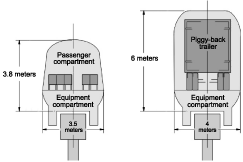 |
Figure 4
PASSENGER AND FREIGHT VEHICLES ON THE M-2000 GUIDEWAY
The schematic drawings show the relative size and configuration of Maglev-2000 passenger and freight vehicles.
|
|
|
|
Moving People and Freight
The second-generation Maglev 2000 system achieves four major innovations over the first-generation Japanese and German systems:
(1) Much lower guideway cost—$12 million per mile, compared to $40 million to $60 million per mile.
(2) Much faster payback times—5 years instead of 50, by carrying piggyback trucks.
(3) Electronic switching of vehicles at high speeds from the main guideway to off-line stations for loading and unloading.
(4) Ability to use existing, conventional railroad tracks for Maglev vehicles.
Key to these innovations are three fundamental Maglev-2000 inventions:
- Mass-produced, low-cost, prefabricated guideway beams and piers.
- Quadrupole magnets (with two pairs of North-South poles, at right angles to each other), which enable vehicles to travel on, and smoothly transition between, both narrow beam and planar guideways.
- Electronic switching from the main guideway to secondary guideway, without any mechanical movement of the guideway’s structures.
|
|
|
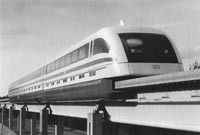 |
Transrapid
In the German Transrapid system, electromagnets are attracted upwards to iron rails at the edges of a T-shaped guideway beam, providing the magnetic force to levitate the vehicle.
|
|
|
|
Figure 3 shows an M-2000 vehicle on a prefabricated narrow-beam guideway. The prefabricated, conventional, reinforced concrete box beams, with their attached aluminum-loop panels, are mass produced at low cost at a factory. The beams are then shipped from the factory, by truck or rail, to the Maglev construction site, along with the prefabricated piers. The only field construction required is the small poured concrete footings for the piers. Cranes lift the beams and piers into place, allowing a complete guideway route to be erected in a few weeks. The beams and piers can also be transported along finished portions of the guideway to the erection site, eliminating the need for road or rail transport. The projected cost of $12 million per mile for the M-2000 elevated narrow beam guideway is based on our fabrication experience for full-size guideway components, including the beam. The projected costs do not include land purchase or modification of existing infrastructure.
Maglev is usually pictured as a high-speed train for intercity passengers, or as a lower-speed system for urban transit. Although these are important applications, the big market for freight transportation in the United States is intercity trucking. The United States currently spends more than $300 billion annually on intercity trucking, compared to only $65 billion per year on intercity air passengers. The biggest intercity air passenger route, Los Angeles to and from New York, carries only about 10,000 passengers daily, while many U.S. Interstates carry 15,000 trucks per day, with some highways carrying more than 25,000 trucks daily. A Maglev route carrying 2,000 trucks per day—20 percent or less of the daily traffic—would take in as much revenue as a route carrying 100,000 passengers per day, which is 10 times greater than the largest intercity air passenger market in the United States.
The average haul distance for intercity trucks is more than 400 miles, with many travelling 1,000 miles or more. Using Maglev, truckers could pick up a load and drive it a few miles to the nearest station. The trailer would be put onto a Maglev vehicle (Figure 4), taking only a couple of minutes. At 300 miles per hour, the trailer could cross the country from California to New York in a few hours, instead of taking days by highway. After arriving at a station near its destination, the trailer would be unloaded and driven to the customer. . . .
|
| Return to top |
|
|
|
|
|
|